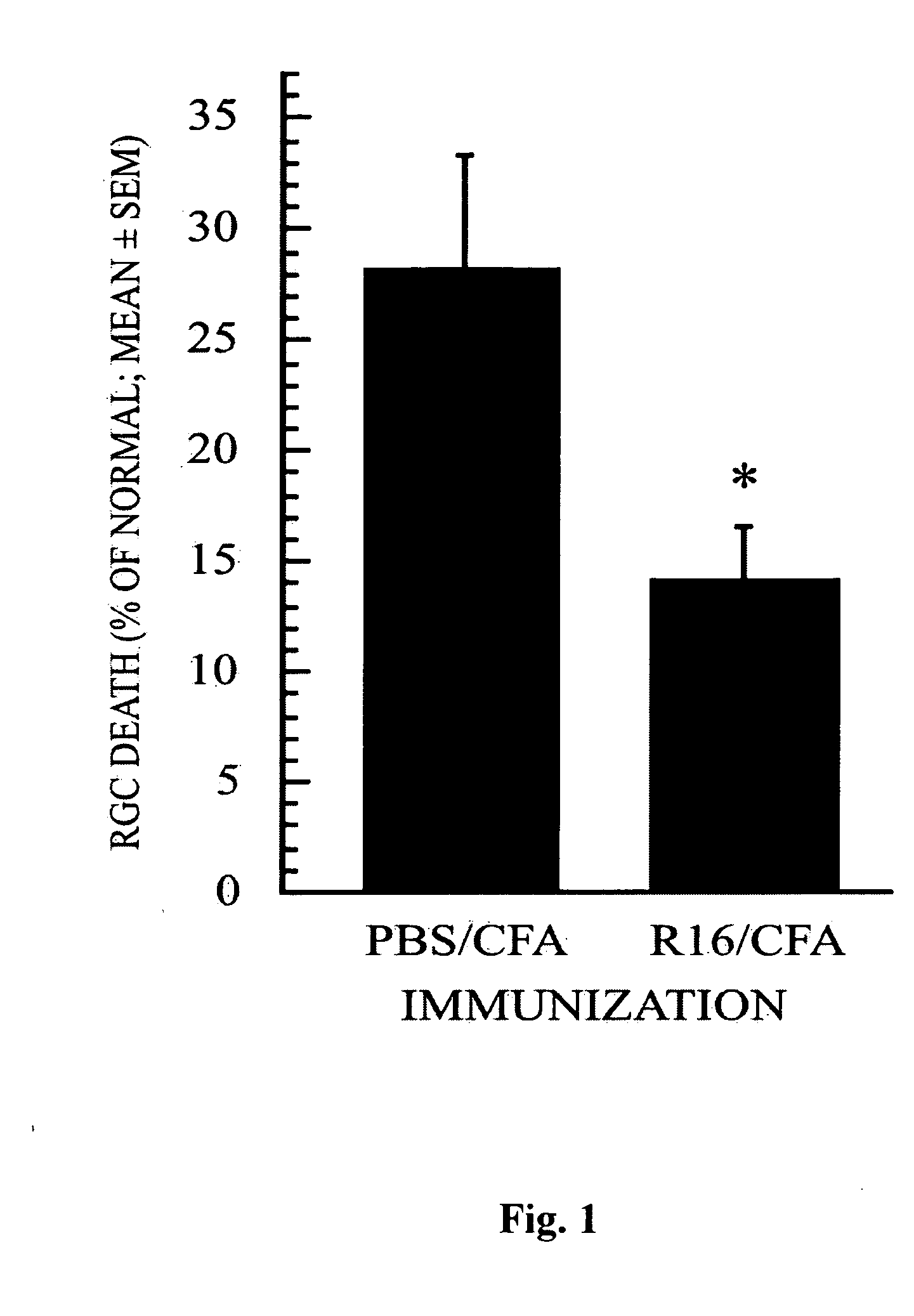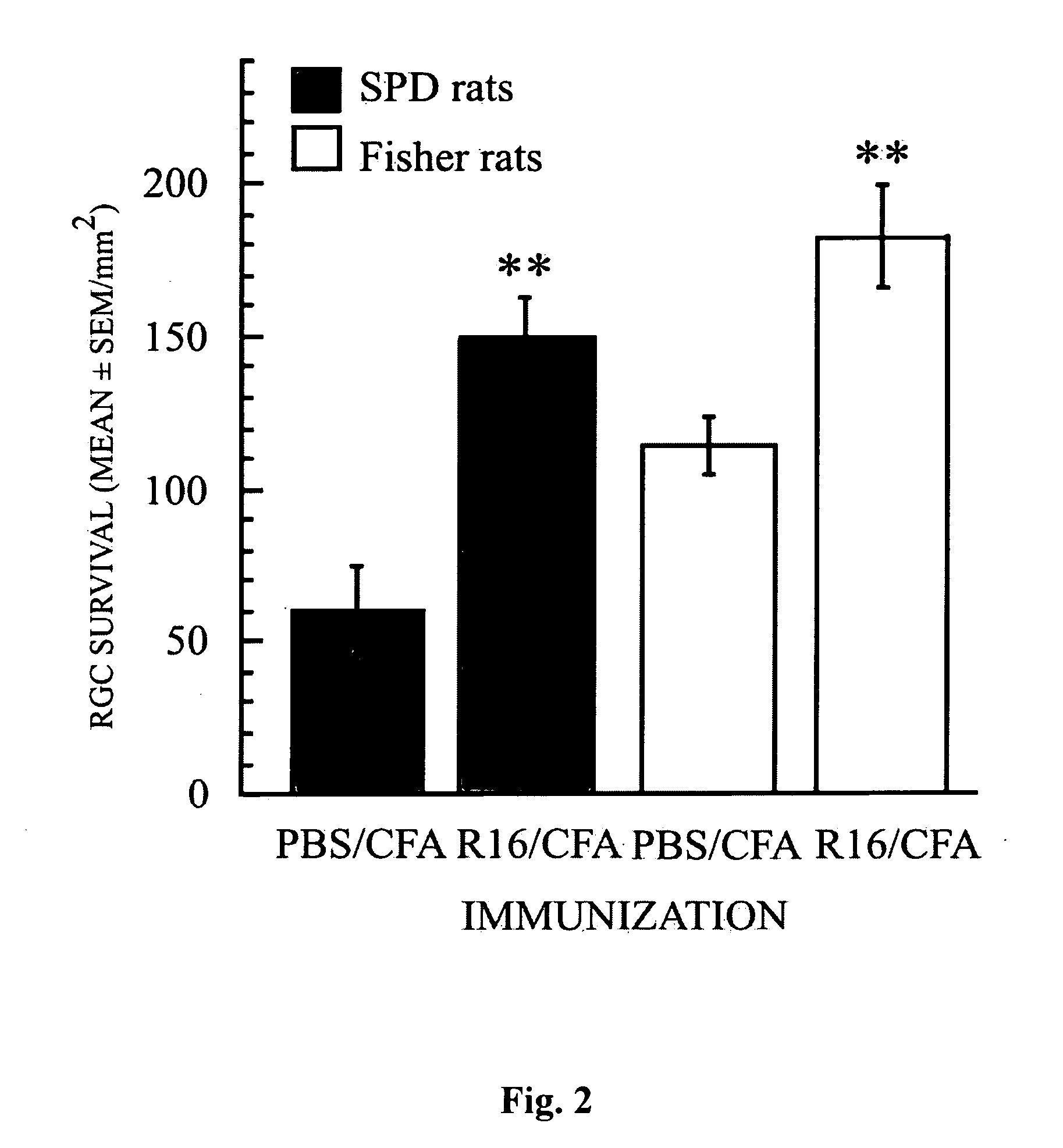Use of an organ-specific self-pathogen for treatment of a non-autoimmune disease of said organ
a self-pathogen and organ technology, applied in the field of immunology, can solve the problems of being hostile to the remaining tissue, unable to protect the procedure after a direct insult to the rgcs itself, and both potentially protective and destructive cells
- Summary
- Abstract
- Description
- Claims
- Application Information
AI Technical Summary
Benefits of technology
Problems solved by technology
Method used
Image
Examples
example 1
Uveitogenic Peptide Derived from IRBP Protects Against Glutamate-Induced RGC Loss
[0087] To test our working hypothesis, we first investigated whether RGCs can be protected by vaccination with a self-peptide associated with uveitis, an autoimmune disease affecting the eye. The peptide selected for this experiment was R16 (SEQ ID NO:1), an immunodominant sequence within IRBP known to cause uveitis. First we examined whether vaccination with R16 could protect the RGCs of Lewis rats (a strain susceptible to autoimmune disease induction) from glutamate toxicity under conditions where immunization with myelin peptides was not effective (Schori et al, 2001b). Vaccination of Lewis rats with R16 after a glutamate insult indeed resulted in a reduced loss of RGCs (FIG. 1). Relative to normal retinas, the percentage of RGC loss (mean±SEM) was 14±2% in rats vaccinated with R16 emulsified in CFA compared with 28±4% in rats treated with PBS in CFA (p<0.04). This finding substantiates our contenti...
example 2
Uveitogenic Peptide Derived from IRBP Protects Retinal Ganglion Cells from the Consequences of Optic Nerve Injury
[0088] Next we examined the effectiveness of R16 vaccination in protecting RGCs from secondary degeneration after optic nerve crush, an insult known to trigger secondary degeneration initiated in the cell bodies or axons of neurons that escaped direct injury (Yoles and Schwartz, 1998b). This examination was conducted in the two resistant rat strains (SPD and Fisher) and in the susceptible strain (Lewis). In all three strains, vaccination with R16 emulsified in CFA (with the high bacterial content of 2.5 mg / ml) on the day of injury significantly reduced the injury-induced loss of RGCs (FIGS. 2 and 3). In SPD rats, the number of surviving RGCs per square millimeter (mean±SEM) was 150±13 in rats immunized with R16 in CFA and 60±14 in rats injected with PBS in CFA (p<0.01; FIG. 2). The corresponding results were 183±16 and 114±9, respectively, in Fisher rats (p<0.01; FIG. 2)...
example 3
Peptides Derived from S—Ag Protect Against Retinal Ganglion Cell Loss as a Consequence of Optic Nerve Injury
[0091] To gain further support for the idea that the protective response is antigen-specific, we used two additional uveitogenic epitopes, G-8 (SEQ ID NO:4) and M-8 (SEQ ID NO:6) of another retinal autoantigen, S—Ag, and their immunogenic, but not immunopathogenic, analogs (SEQ ID NO:5. and SEQ ID NO:7, respectively). As with R16, vaccination with the uveitogenic peptides G-8 and M-8 or their immunogenic analogs immediately after optic nerve crush injury, resulted in a significant increase in RGC survival in Fisher rats. The numbers of surviving RGCs per square millimeter (mean±SEM) were 159±5, 153±10, and 159±19 in rats immunized with 200 μg G-8, M-8, or M-8 analog in CFA and 109±12 in rats injected with PBS in CPA p<0.01, p<0.03, and p<0.04, respectively; FIG. 5A). In the case of the G-8 analog, immunization with 500 μg (but not with 200 μg) of the peptide resulted in a sig...
PUM
| Property | Measurement | Unit |
|---|---|---|
| Fraction | aaaaa | aaaaa |
Abstract
Description
Claims
Application Information
 Login to View More
Login to View More - R&D
- Intellectual Property
- Life Sciences
- Materials
- Tech Scout
- Unparalleled Data Quality
- Higher Quality Content
- 60% Fewer Hallucinations
Browse by: Latest US Patents, China's latest patents, Technical Efficacy Thesaurus, Application Domain, Technology Topic, Popular Technical Reports.
© 2025 PatSnap. All rights reserved.Legal|Privacy policy|Modern Slavery Act Transparency Statement|Sitemap|About US| Contact US: help@patsnap.com



